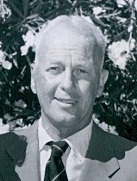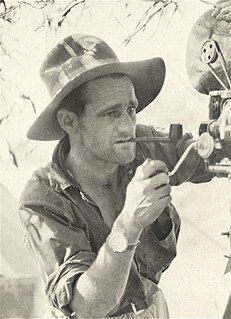
Sir Charles Edward Kingsford Smith, MC, AFC, often called by his nickname Smithy, was an early Australian aviator.

Smithy is a 1946 Australian adventure film about pioneering Australian aviator Sir Charles Kingsford Smith and his 1928 flight across the Pacific Ocean, from San Francisco, California, United States to Brisbane, Queensland, Australia. This was the first-ever transpacific flight. Kingsford Smith was the pilot of the Fokker F.VII/3m three-engine monoplane "Southern Cross", with Australian aviator Charles Ulm as the relief pilot. The other two crew members were Americans James Warner and Harry Lyon.

John Villiers Farrow, KGCHS was an Australian film director, producer, and screenwriter. Spending a considerable amount of his career in the United States, in 1942 he was nominated for the Academy Award for Best Director for Wake Island, and in 1957 he won the Academy Award for Best Adapted Screenplay for Around the World in Eighty Days. He had seven children by his wife, actress Maureen O'Sullivan, including actress Mia Farrow.

The Southern Cross is a Fokker F.VIIb/3m trimotor monoplane that was flown by Australian aviator Charles Kingsford Smith, Charles Ulm, Harry Lyon and James Warner in the first-ever trans-Pacific flight to Australia from the mainland United States, a distance of about 11,670 kilometres (7,250 mi), in 1928.

Cinesound Productions Pty Ltd was an Australian feature film production company, established in June 1931, Cinesound developed out of a group of companies centred on Greater Union Theatres, that covered all facets of the film process, from production, to distribution and exhibition.

Guy Lambton Menzies was an Australian aviator who flew the first solo trans-Tasman flight, from Sydney, Australia to the West Coast of New Zealand, on 7 January 1931.
The Southern Cross was an Australian automobile produced between 1931 and 1935. Built by the Marks Motor Construction Company it was intended to retail for under 300 pounds. Volume production of the "Airline" Sedan was planned for 1935 but the marque died with the Chairman, Sir Charles Kingsford Smith.

The Lady Southern Cross was a Lockheed Altair monoplane owned by Australian pioneer aviator Sir Charles Kingsford Smith.

Sir Patrick Gordon Taylor,, commonly known as Bill Taylor, was an Australian aviator and author. He was born at Mosman, Sydney, and died in Honolulu.
The Oswald Watt Gold Medal is an Australian aviation award named for Oswald Watt (1878–1921), a decorated pilot in World War I.

Charles Thomas Philippe Ulm AFC was a pioneer Australian aviator.

Charles James Melrose was an Australian aviator who held a number of flying records, and was the youngest and only solo flier to finish the Melbourne (MacRobertson) Centenary Air Race in 1934.

Raymond Longford was a prolific Australian film director, writer, producer and actor during the silent era. Longford was a major director of the silent film era of the Australian cinema. He formed a production team with Lottie Lyell. His contributions to Australian cinema with his ongoing collaborations with Lyell, including The Sentimental Bloke (1919) and The Blue Mountains Mystery (1921), prompted the Australian Film Institute's AFI Raymond Longford Award, inaugurated in 1968, to be named in his honour.
The Squatter's Daughter is a 1933 Australian melodrama directed by Ken G. Hall and starring Jocelyn Howarth. One of the most popular Australian films of the 1930s, it is based on a 1907 play by Bert Bailey and Edmund Duggan which had been previously adapted to the screen in 1910.
A Ticket in Tatts is a 1934 musical comedy film starring popular stage comedian George Wallace as an accident-prone stablehand. It was the last of three films Wallace made for F. W. Thring.
Splendid Fellows is a 1934 Australian film from director Beaumont Smith about an Englishman who comes to Australia. The cast includes Eric Colman, brother of Ronald Colman, and Sir Charles Kingsford-Smith, who has a cameo as himself. It was Smith's last film.

Ernest Gustav Brandon-Cremer was a New Zealand/Australian moviemaker, newsman, explorer and adventurer. He was a key figure in Australian aviation history, and was especially known for his documentation of Lasseter's Gold Reef as well as his photography of the Solar eclipse of 21 September 1922 at Wallal, Australia.

A transpacific flight is the flight of an aircraft across the Pacific Ocean from Asia or Australia to North America, Central America, or South America, or vice versa. Such flights have been made by fixed-wing aircraft, balloons and other types of aircraft.
Keith Vincent Anderson was an Australian pilot who died during the search for Charles Kingsford Smith, whose aircraft Southern Cross 's overdue arrival created national apprehension for the safety of the great aviator.

George Henry "Harry" Purvis, AFC was an Australian pioneer aviator, engineer, airline pilot, air-force pilot and author. He was the engineer responsible for maintenance of the famed Southern Cross aircraft. Purvis often flew as co-pilot with Sir Charles Kingsford Smith and was the last person to fly the Southern Cross. Purvis was co-pilot to P. G. Taylor on the first flight across the lower Pacific Ocean from Australia to South America, landing in Chile in 1951.














